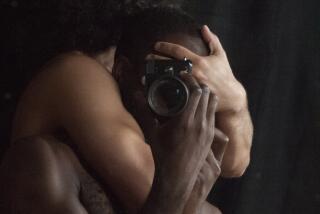Wilshire Center
- Share via
A veil of polite fictions separates the photographs of Baron Adolph de Meyer from our more crass era. His romantic platinum-palladium and silver prints limning society figures and theater folk of the first few decades of the century are not so much personality studies as they are carefully lit and furnished set pieces evocative of the sheen of social standing or world-shaking talent.
Women pose in satins and furs against gleaming backgrounds that set off their three-quarter-view or profiled faces with a medley of silvery grays and gleaming whites.
Mrs. Edward G. Robinson casually drapes her arm over what appears to be a Rodin sculpture. Anita Louise’s brocade dress describes a regal curve against her chair. Josephine Baker, tightly wrapped into a long white dress that ends in a fuzzy train, poses against a shiny wall that picks up the luster of her pearls and the whites of her eyes.
Early on, when De Meyer ventured into the real world, his images took on the look of film stills. It’s not hard to imagine Marie Dressler as the “Peasant Woman” of about 1900 with baleful eyes and a clumsily made coat. But the drawing room was the photographer’s true element, and there he posed himself around 1930 in debonair leisure attire, looking rather like Cole Porter. (G. Ray Hawkins Gallery, 7224 Melrose Ave., to Oct. 24.)
More to Read
The biggest entertainment stories
Get our big stories about Hollywood, film, television, music, arts, culture and more right in your inbox as soon as they publish.
You may occasionally receive promotional content from the Los Angeles Times.










